![]() UNEVEN ELECTRODE SPACING
UNEVEN ELECTRODE SPACING
Rotary spark gaps usually use electrodes which are evenly spaced around the circumference of the rotating disc. This results in firings which are evenly spaced over time. Although this approach is common, it is not essential, and there are several benefits obtained by staggering electrode positions.
Evenly spaced electrodes provide a fixed time in which the tank capacitor must charge. This works very well for systems fed from a DC supply, where the current is constant over time, and the capacitor charges at a constant rate. However, most Tesla Coil systems are supplied from a sinusoidal AC source. This causes the charging current to vary throughout each cycle of the AC supply. The tank capacitor actually recharges most quickly when the supply current is near the peak of a cycle, and more slowly when the supply is near to zero.
Therefore, the times between firings should be chosen to compensate for the different charging rates. Where the supply current is high, the capacitor will recharge quickly, so only a small time is required and electrodes should be closely spaced. In contrast, where the supply current is low, the capacitor will recharge slowly, so more time is required and the electrodes need to be more widely spaced. This leads to the concept of staggered electrodes.
The picture below shows a 200BPS synchronous rotary spark gap with staggered flying electrodes.

It was found that by staggering the electrode spacing only slightly, a significant increase in both power throughput and power factor could be achieved.
The theory says that for best effect the electrode spacings should be inversely proportional to the average charging rate at that point in the AC cycle. Electrode positions can be calculated by dividing up the area under the AC supply waveform into equal areas:
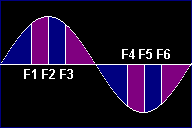
In practice, computer simulation is a more effective way of "trying" different electrode positions. It is also more accurate because it will take into account phase shift and resonance introduced by the charging circuit. (The peaks of the charging current actually do not coincide with the peaks of the supply voltage !) Microsim simulation files are included in the simulation section for evaluating the effect of offset eleectrodes, in both 200BPS and 300BPS synchronous systems.
The following analysis is only concerned with the effect of staggering electrodes in the 200BPS synchronous case, because little practical work has been carried out at higher speeds.
In a normal 200BPS sync rotary there are four evenly spaced firings per complete cycle of the AC supply waveform. This gives two bangs of equal magnitude for each half cycle of the AC supply waveform, when the rotary phase is set correctly. (Firings F1, F2, F3, F4 are all separated by 5ms.)
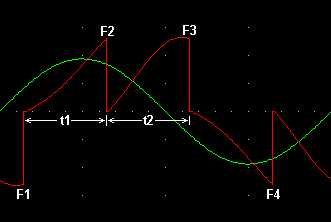
Although this arrangement performs well, an increase in power can be achieved by causing firings F2 and F4 to occur earlier in the AC supply waveform. Firings F1 and F2 remain fixed. (ie. t1 is made smaller, an t2 is made bigger)
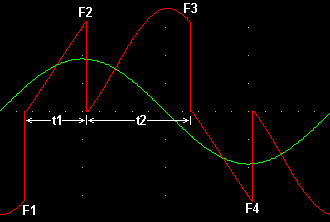
By advancing F2, we have allowed more time (t2) for the capacitor to recharge on the weaker "down-slope" of the AC supply waveform before being discharged at F3. Similarly, advancing F4 allows more time for the capacitor to recharge on the "down-slope" of the negative cycle. The result is that the tank capacitor charges to a greater voltage during the "down-slope" before firing at F1 and F3.
However, the advancing of firings F2 and F4, means that they are now closer to the preceding firings at F1 and F3. The capacitor now has less time (t1) to charge on the "up-slope" of the AC supply waveform. It is therefore natural to expect the voltage at the end of these charging periods to be lower than before. This is not the case however.
The lengthened charging period t2 on the down-slope of the AC waveform not only increases the capacitor charge. The prolonged current flow through the ballast inductor results in more energy being stored in the ballast during t2. This extra energy is released in the shortened up-slope charging time t1. The result is that firings F2 and F4 increase in amplitude also !
This peculiar behaviour is due to the inductive kick effect. In practice it allows us to advance the firing points on the "up-slope" of the charging waveform considerably, resulting in increased firing voltages at all firings.
Since power throughput is proportional to V squared, any increase in V gives a significant increase in power throughput.
The animation below shows the benefit of advancing the "up-slope" firings graphically. The green waveform represents the normal open circuit voltage of the power supply, and the red waveform represents the tank capacitor voltage. The diagram in the top right of the picture indicates the approximate positions of the electrodes on a 3000RPM rotary disc.
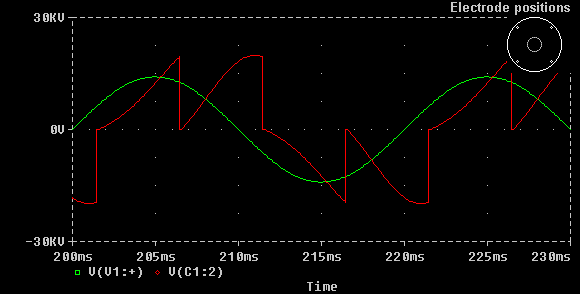
Initially the electrodes are evenly spaced as is normal practice. (spaced 50/50)
The electrodes are gradually staggered, causing the up-slope firings to be progressively advanced. The resulting increase in firing voltage is apparent at all four firings.
Notice the voltage overshoot which occurs just before the down-slope firings when the electrodes are highly offset. This is a sign that the electrodes are becoming offset too much. If the down-slope charging time is made too long, considerable energy begins to flow from the tank capacitor back into the ballast inductor just before the spark gap fires.
The firing voltage increases steadily with increasing electrode offset, but there is a limit to the amount by which the electrodes can be offset. In practice, the maximum electrode offset is dictated by the amount of voltage overshoot which the transformer and tank capacitor can withstand during operation. (It should be noted that the voltage overshoot is a nuisance because it causes component stresses but does not give any increase in performance.)
Another graph showing the effect of more excessive electrode offsets on charging voltage is shown below:

After much simulation, I decided to include a modest electrode offset into the design of my new synchronous rotary pictured above. I chose to offset the electrodes such that the charging times became t1=4.44ms and t2=5.56ms. This allowed the effect of a small electrode offset to be studied in an real working 2kW system.
The system uses a 10kv/225mA inductively ballasted power supply, and the simulation results below show performance with a wide range of tank capacitors. The behaviour with 4.44/5.56 offset is shown by the dotted line, along with behaviour with a normal 5/5 spaced rotary in purple.
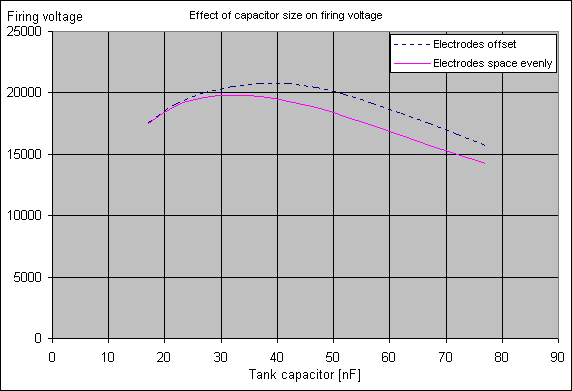
The graph above shows the effect of offset electrodes on the firing voltage when using a variety of tank capacitor values. It can be seen that even the relatively small offset gives an increase in firing voltage when large capacitors are used. For a chosen capacitor size of 47nF, the offset electrodes give a firing voltage of 20kv, compared to 18kv with a conventional rotary using evenly spaced electrodes. This is an increase in voltage of 11%, just by staggering the electrodes slightly.
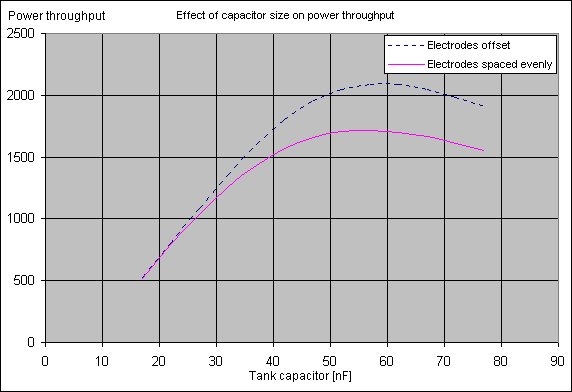
Since power throughput is proportional to firing voltage squared, the offsetting of electrodes gives a considerable increase in power. For the chosen capacitor size of 47nF, the power throughput is 2010W, compared with only 1650W in the case of an evenly spaced rotary. This is an increase in power throughput of 23% just by staggering rotary electrodes.
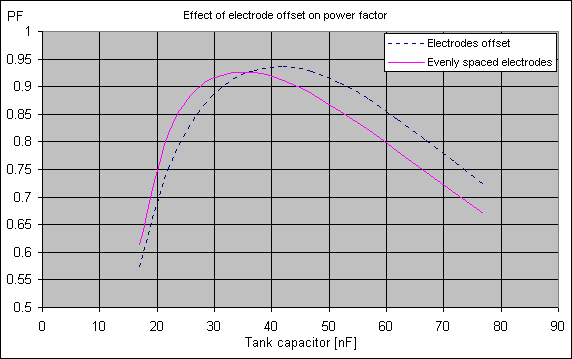
The graph above shows the effect of using offset electrodes on the power factor of the system. It can be seen that the best power factor occurs with a larger tank capacitor fitted when the electrodes are offset. This is good because it enables a larger tank capacitor to be used to take advantage of the characteristics shown in the other two graphs above. With large tank capacitors the power factor is always better with electrode offset. With the chosen 47nF tank capacitor the power factor is 0.92 with offset electrodes compared to 0.87 with a normal rotary.
In practice this increase in power factor means that although the power throughput has increased by 23%, the supply cord current only increases by roughly 16%, because the system is effectively appears as a purer load and is "more efficient".
The 200BPS synchronous rotary was built as described with electrodes offset to provide charging times of 4.44ms and 5.56ms. This rotary was run with the 10kv/225mA supply driving an actual tesla coil, and power transfer measurements were taken.
During use the first thing which was apparent was the change in sound from the TC discharge when compared to my equally spaced rotary. The evenly spaced 200BPS rotary gives a pure 200Hz whining sound, whereas the new gap with offset electrodes gives a much harsher and more raspy sound. It sounds more like a mixture 100Hz and 200Hz.
At power levels below 1500W the sparks were definitely longer with the offset electrodes, but it was hard to make a quantifiable comparison due to the time taken to swap rotary disks between tests. I would that spark length increased by something like 10 or 15%. During these tests supply VA, supply Watts, and the Capacitor Firing Voltage were measured, and found to be highly consistent with simulation results.
However, above 1500W a slight plateau in performance was noted. This is believed to be caused by mild saturation of the power transformers, and is probably due to the increase in firing voltage caused by offsetting the electrodes. This requires further investigation.
For 200BPS synchronous rotary designs, a considerable increase in performance can be achieved by offsetting electrodes in order to provide more charging time on the "down-slope" of the supply waveform:
|
Parameter |
Typical change by offsetting electrodes to 4.44ms:5.56ms |
|
Firing voltage |
Increase by 11%, |
|
Power throughput: |
Increase by 23% |
|
Supply cord current: |
Increase by 16% |
|
Power factor: |
Increase from 0.87 to 0.92 |
|
Spark length: |
Increase by about 15% |
Although the amount of offset discussed here was quite small, the effect is noticeable during operation of a real system. Also a cautious amount of electrode offset was used in the design of the rotary in order to see the effect in its mildest form. In practice more offset of the electrodes may yield further increases in performance, provided components do not become stressed or saturate. It is also anticipated that the benefit from staggering electrodes will be greater for higher speed rotary gaps such as 300BPS or 400BPS. Much work is still to be done in this area.
Since electrodes are staggered relative to the up-slope and down-slopes of the AC supply waveform, staggered electrodes are only beneficial in synchronous systems running at firing rates of 200BPS or more. At 100BPS there is only 1 firing per half cycle, so staggering is not possible. Staggering electrodes in an asynchronous system is pointless since the firing points are constantly moving along the AC supply waveform. (It is actually undesirable since it exaggerates the surging effect in asynchronous systems.)